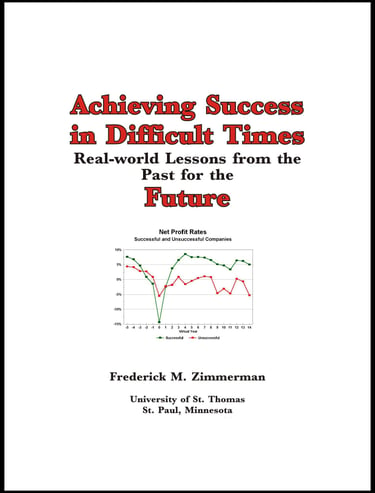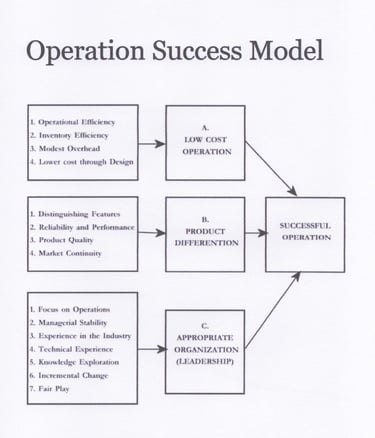The practicing manager will be primarily interested in two basic questions: Is it possible for troubled companies to come back from difficulty to become strong economic contributors once again? How do they do it? The evidence gathered in this inquiry, along with the evidence gathered by others suggests that it is possible for troubled companies to turn around. The successful companies studied here had no special advantages which were unavailable to the unsuccessful companies. Successes and failures emerged during the same economic times. The successful and unsuccessful companies were serving the same industries and, in several cases, the unsuccessful firms were more established. All experienced adversity. Yet, some companies found a way to successfully emerge from adversity and others failed.
What the successful companies did to survive was a process of organizational learning involving an intricate combination of strategy, thrift, technical expertise and industrial experience superimposed on a framework of traditional morality, personal integrity, and clearly articulated, focused ideals.
The general proposition advanced here is that a successful business turnaround involves improving the company's position as a low-cost provider of increasingly differentiated products and services, along with the nurturing of an appropriate turnaround organization which is competent, possesses industry-oriented technical expertise, and employs a general sense of fair play in dealing with employees, creditors, suppliers, shareholders, and customers.
Successful turnarounds involve this very special form of leadership.
A more detailed description of the model being described is that successful turnarounds are a function of three principal factors:
1. A strategy that focuses primarily on improving the firm's effectiveness as a low-cost operator. Low-cost operation implies the design of products for manufacturability, the attainment of high rates of manufacturing and inventory efficiency, and the containment of overhead costs to below industry levels.
2. A strategy that focuses at a later stage on improving the firm's effectiveness as a provider of increasingly differentiated products. Producing differentiated products implies products with distinguishing features, high reliability, and significant performance, exceptional product quality, and the development of long-term continuity with the markets being served so that product differentiation can be recognized by potential buyers.
3. Leadership involves turnaround agents who have significant experience in the industry being served and in some technical function, such as manufacturing or engineering, and have a major propensity to focus on operational issues such as manufacturing, product development, and sales. Successful turnaround agents tend to have longer term associations with the company and make incremental changes based on information which is appropriate to the decisions being made. Successful turnaround agents enjoy generally favorable personal reputations and employ a sense of fair play in dealing with employees, creditors, suppliers, and customers, and focus intensely on the important operational questions that are pertinent to the business the firm is in at the time.
Can companies and organizations be turned around?
Dr. Frederick M. Zimmerman has written extensively on company revitalization, has given many presentations on company revitalization, and has served on the boards of directors of more than ten companies. His assertion is that low-cost, high product differentiation, and appropriate leadership are all essential conditions for company revitalization.
The stories related in both The Turnaround Experience and Achieving Success in Difficult Times are all real-world cases describing not only technical details, but also characteristics of the people involved.
Achieving Success in Difficult Times






